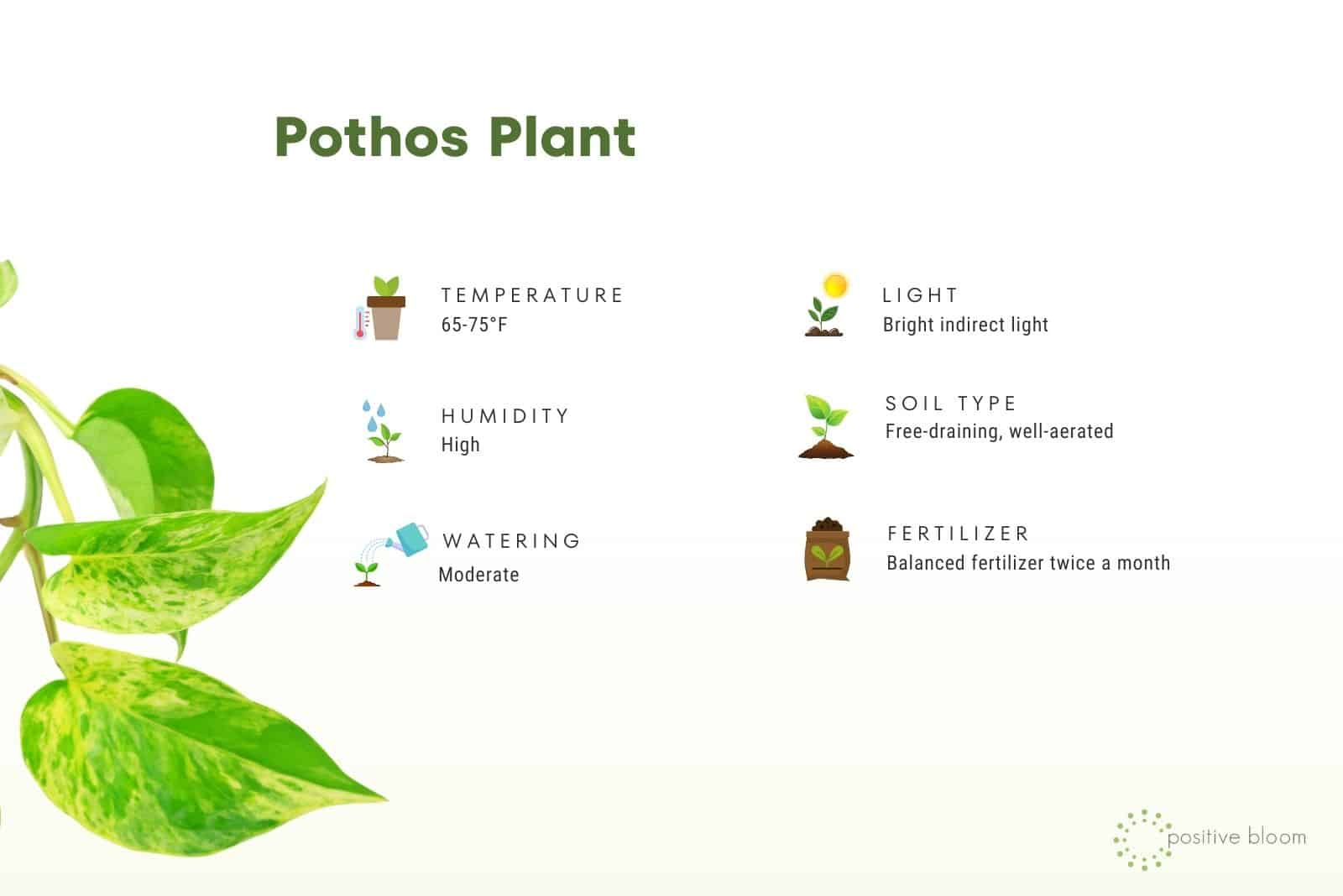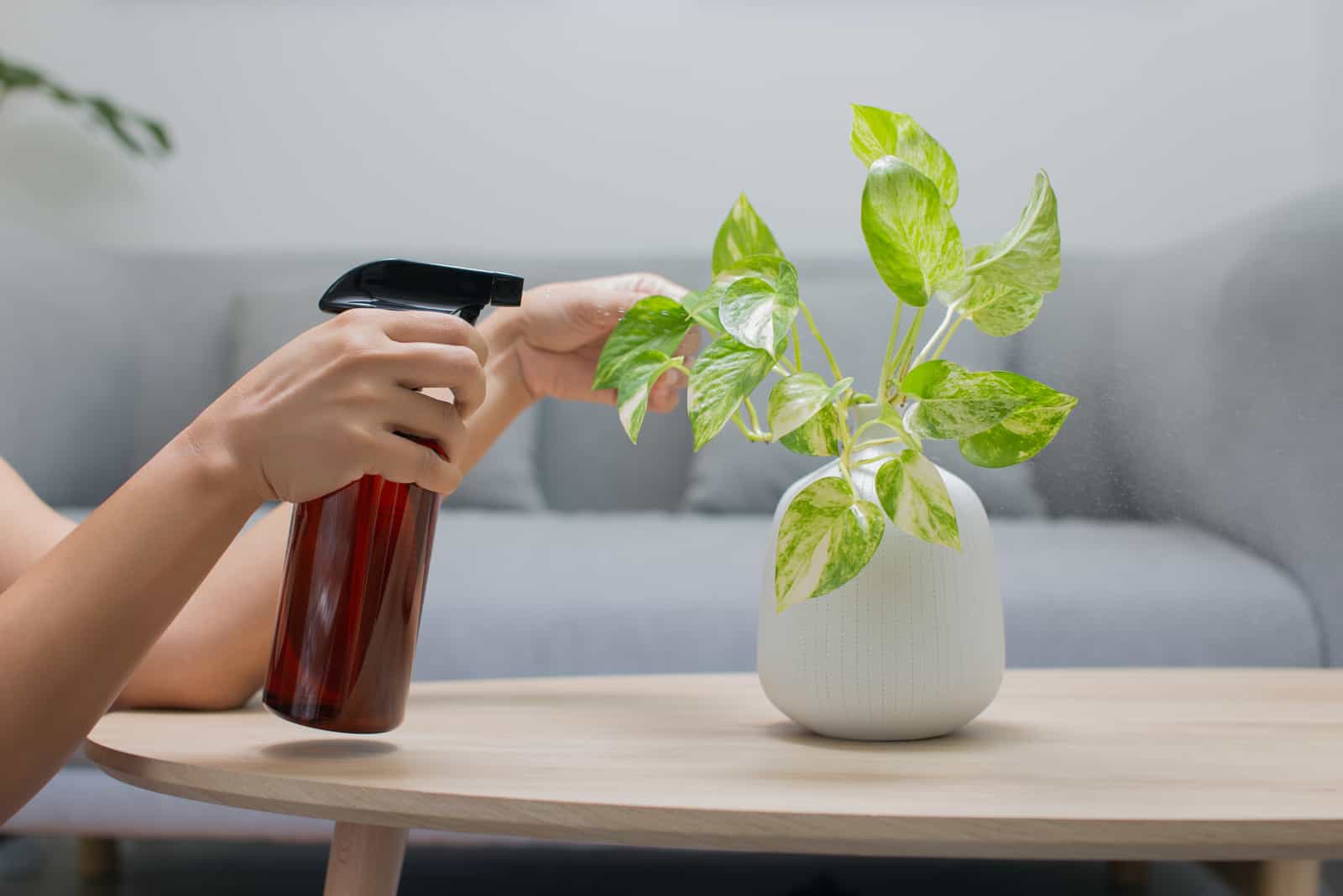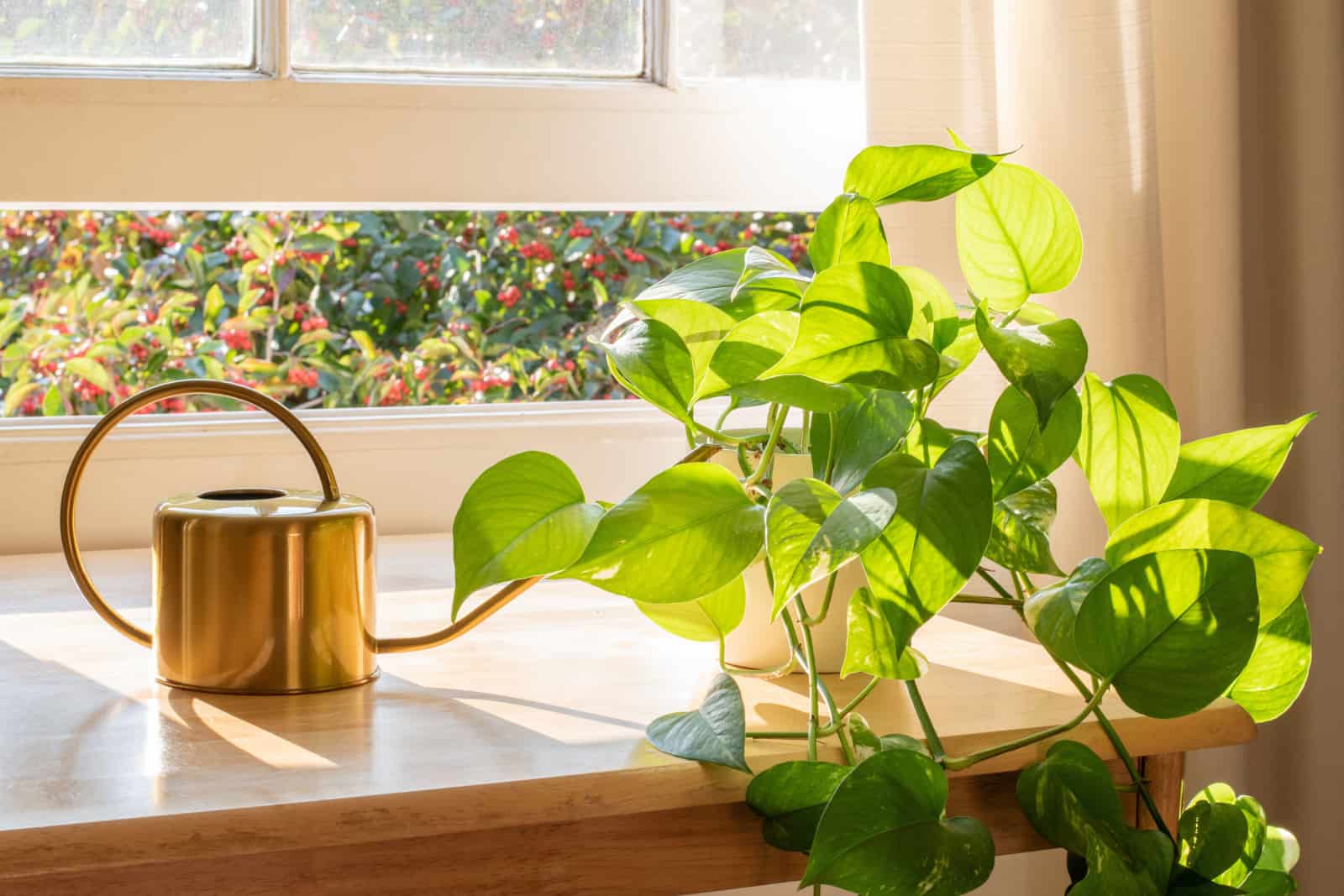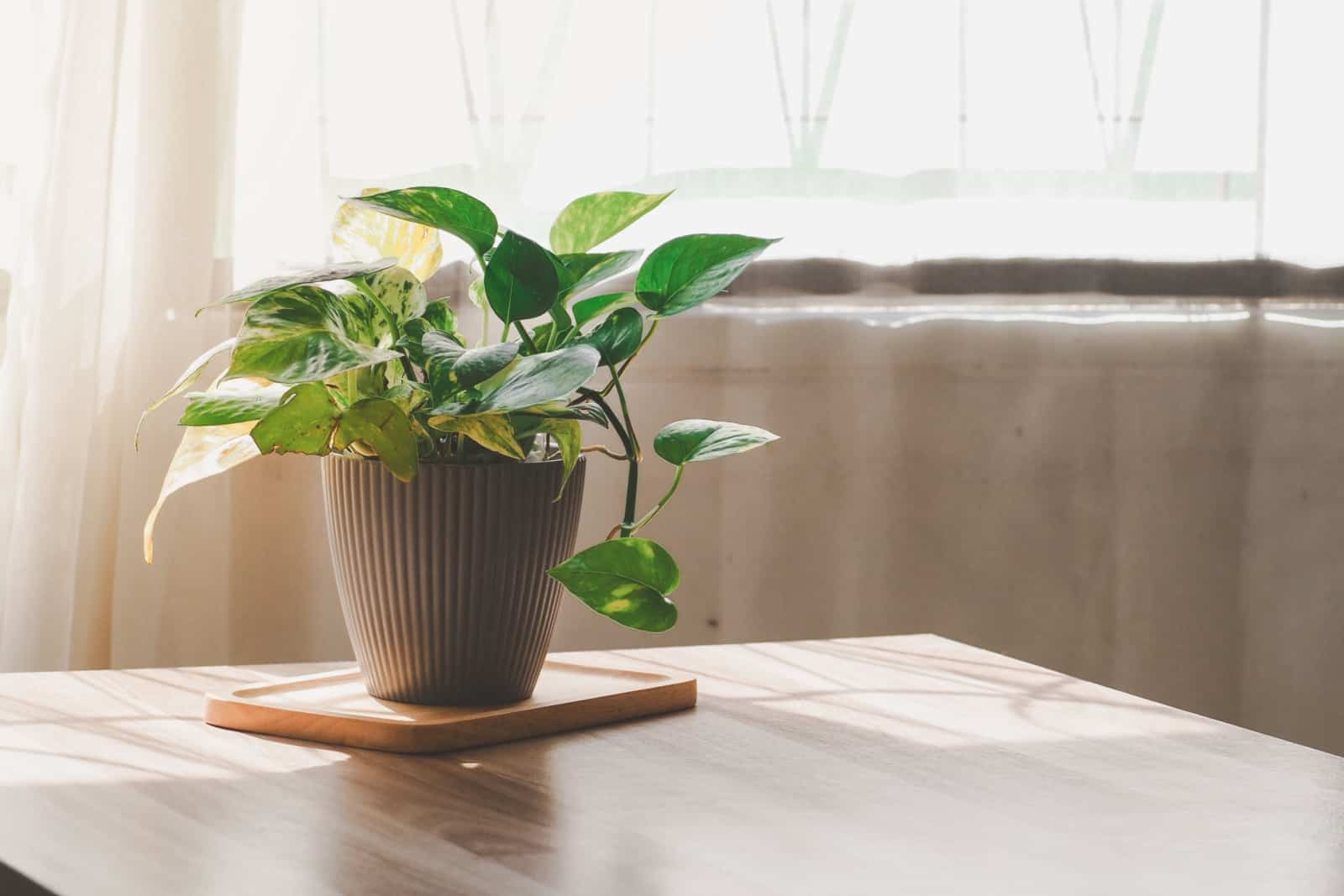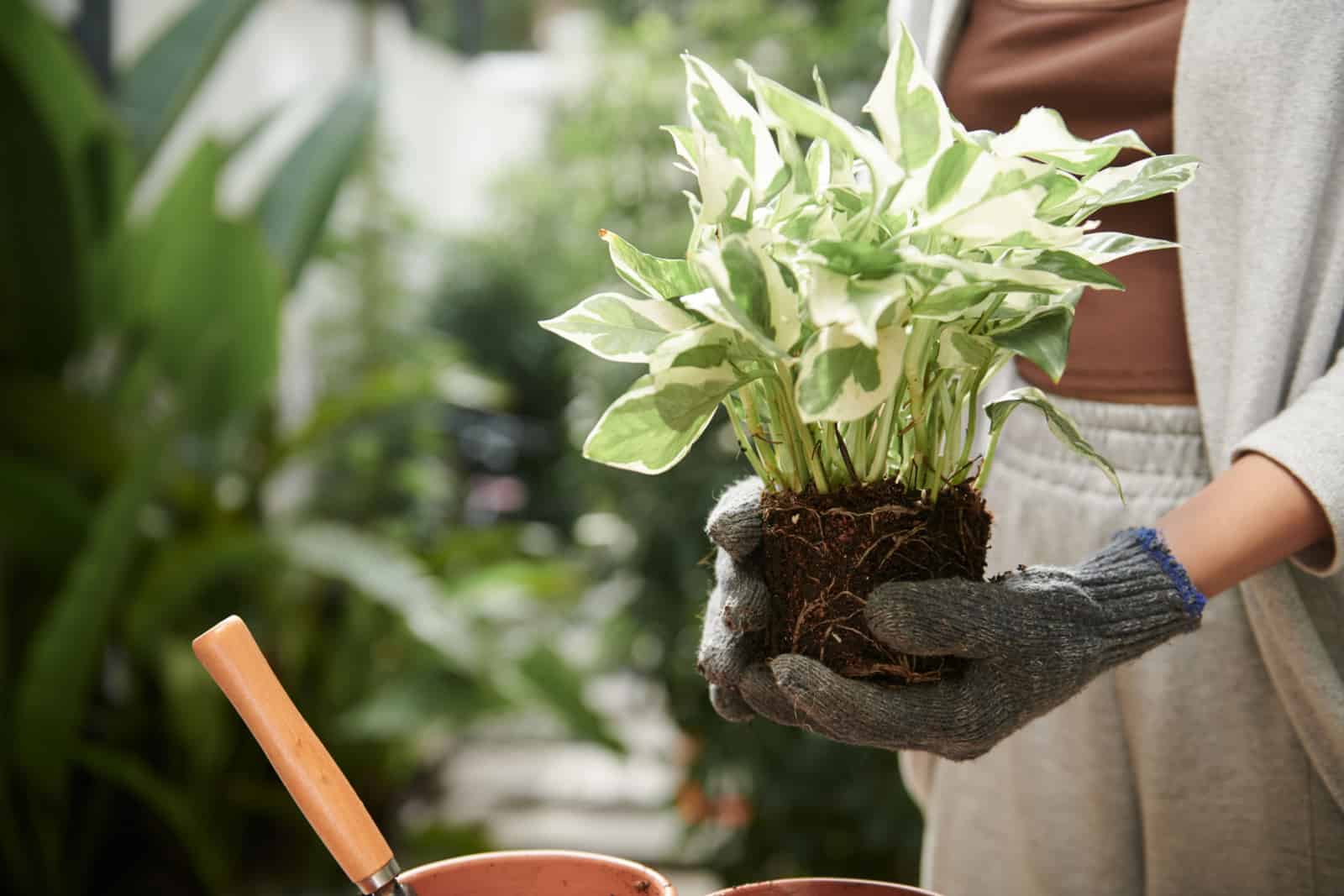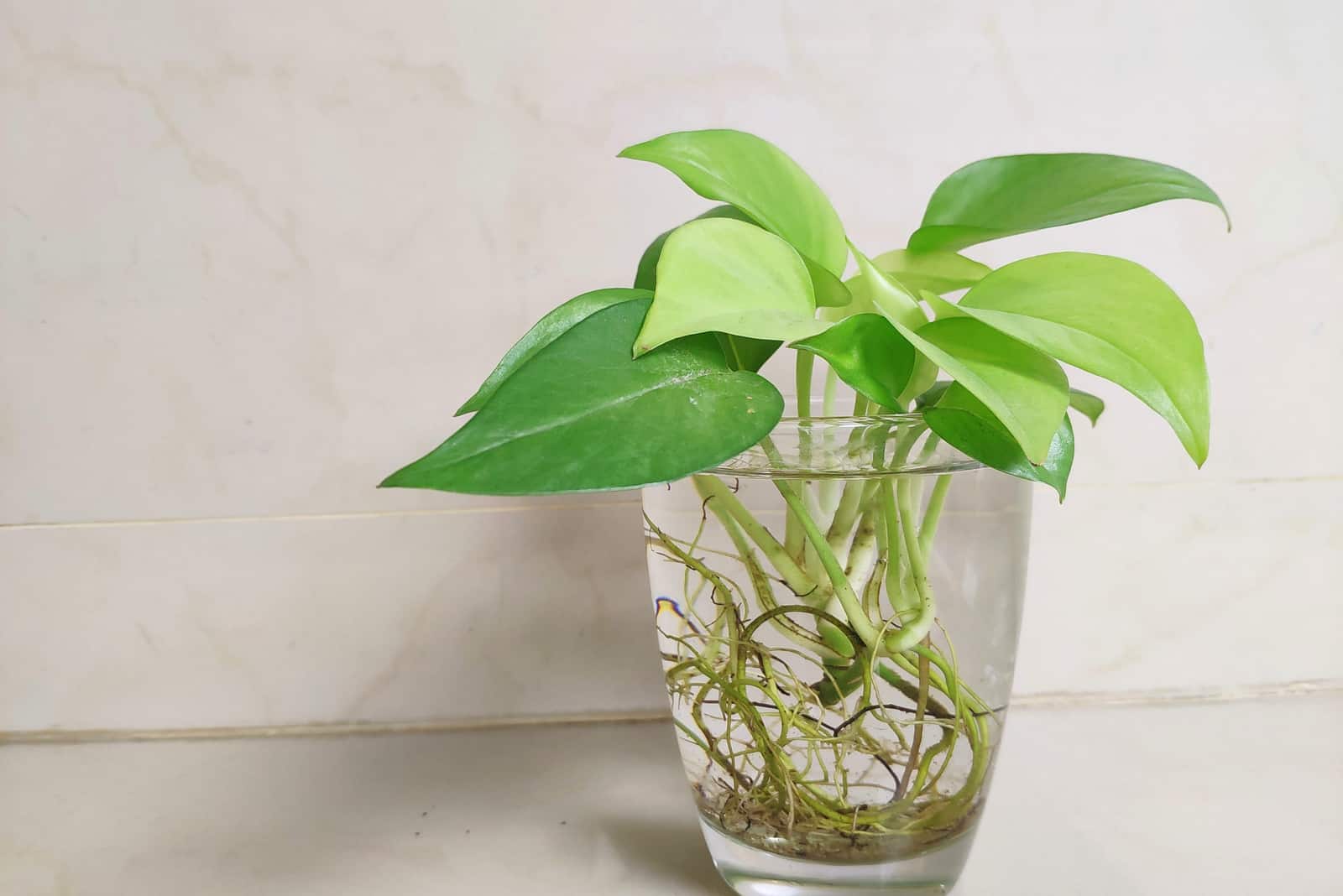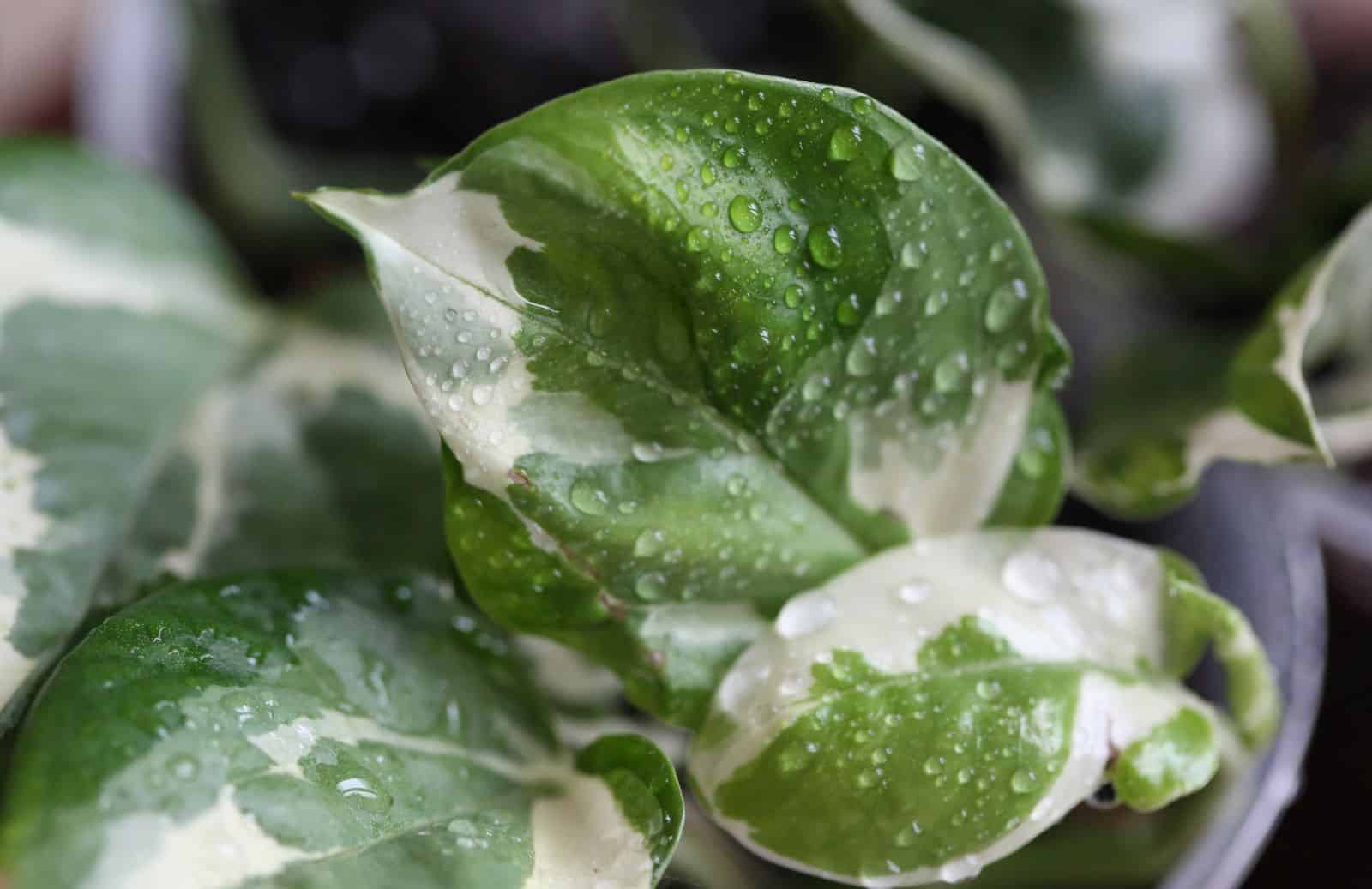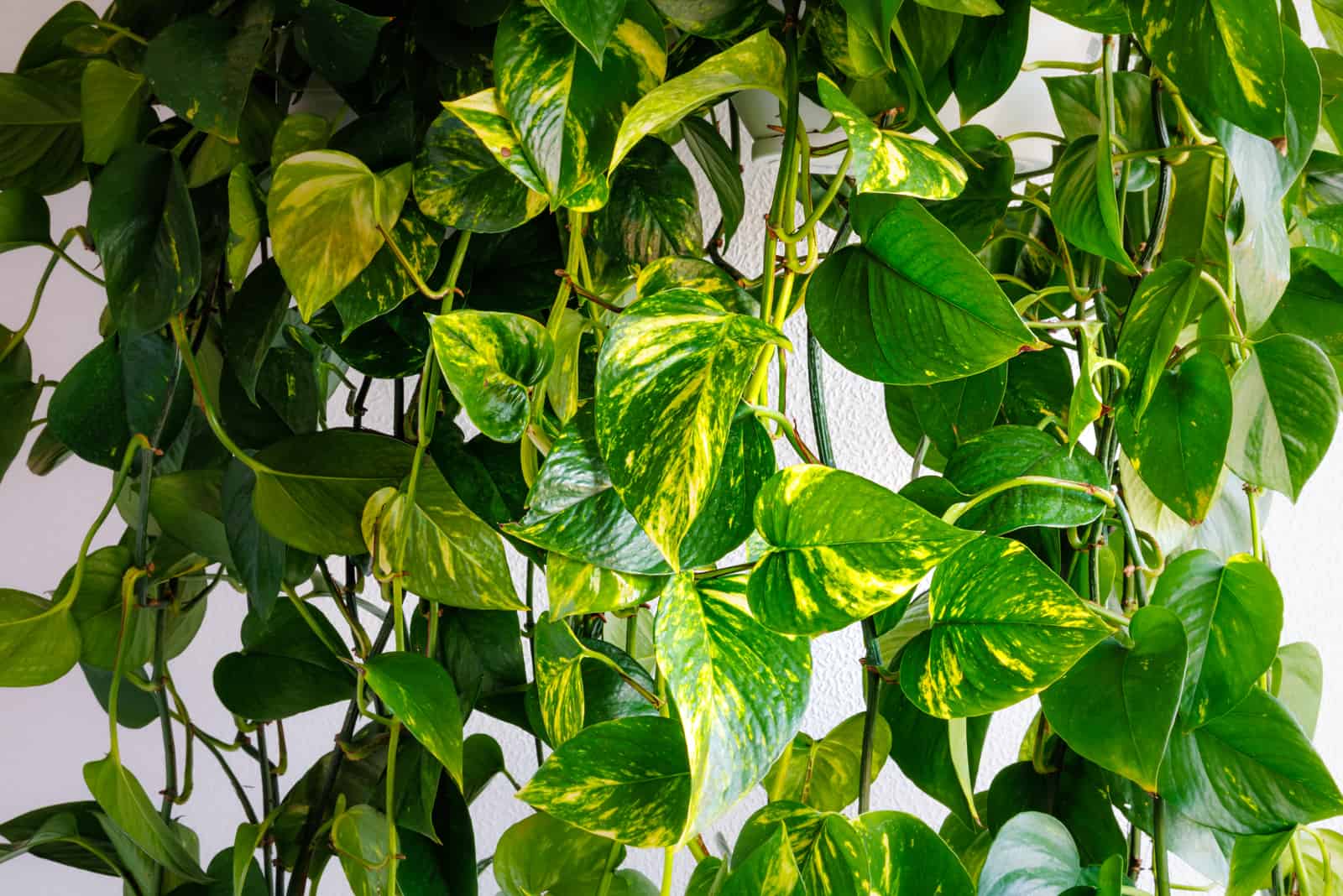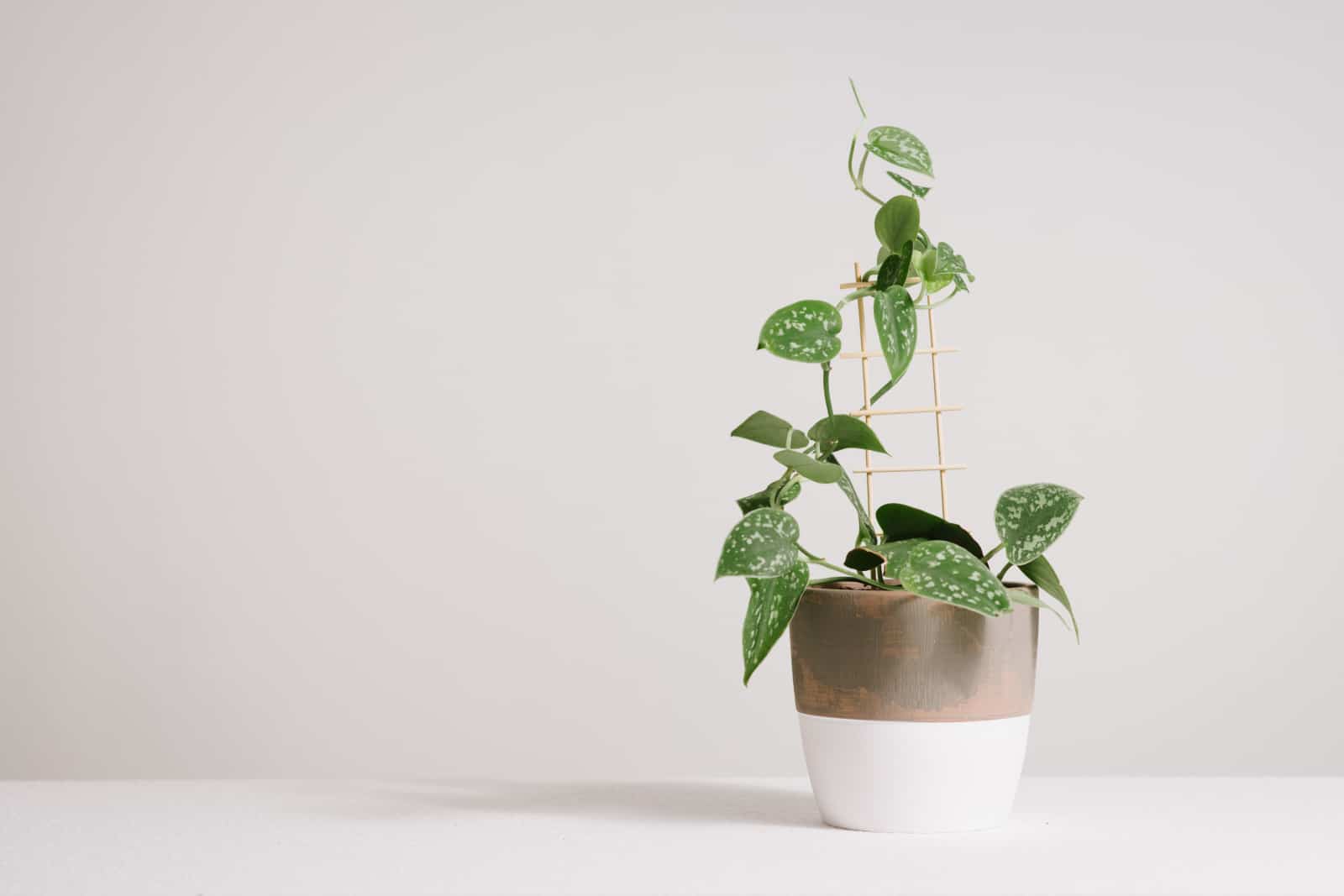A Pothos was one of the first plants in my houseplant collection. Since then, I have recommended growing these species to everyone.
Pothos are one of the best green friends; they’ll forgive you if neglect them a little bit and will reward you by producing stunning foliage if you provide suitable growing conditions.
So the question is, what are the perfect growing conditions for a pothos plant?
In this article, I’ll describe what these plants need to flourish and the best methods for cloning these species.
Additionally, I’ll tell you more about potential issues with this common houseplant, and what to pay attention to.
Let’s get started!
Care Guide For A Pothos Plant
Plant species from the Epipremnum genus are some of the easiest houseplants ever. Let’s discuss their care instructions in detail!
Light Requirements
These plants are native to rainforests with low sunlight exposure, and that’s the main reason why pothos plants enjoy bright indirect light when cultivated indoors.
One of the features of these plants is that they respond well to lower light conditions, so they’ll thrive in almost any part of your home.
Of course, it needs light to display new growth and maintain its vigor.
To encourage growth, shield your pothos from direct sunlight while also giving them filtered light. If you expose your pothos plant to direct sun, it may suffer from sunburns, which can lead to severe health issues.
Light conditions affect the watering needs of Devil’s ivy plants, so make sure you adjust light levels accordingly to avoid more problems.
You can put it close to a window with eastern or southern exposure so that it can comfortably enjoy the morning sun.
If you can’t provide such a spot, and only one with northern exposure is available, use artificial lights.
Low light often leads to yellow leaves and your pothos may also droop.
Watering Schedule
New plant parents often give their pothos more water than they need in order to promote growth.
When it comes to these plants, it’s actually better to underwater them; the consequences are less severe than with overwatering.
The growing medium doesn’t need to be soaking wet for your pothos to grow healthy. Too much water in the growing medium leads to fungal diseases; if you overwater your pothos, it may quickly get root rot. Unfortunately, this disease is lethal if not detected early enough.
You need to add water when the few top inches of the growing substrate dry out, which could be once a week in the summer months (growing season) and every two weeks when your pothos is dormant.
You can’t rely on this watering schedule entirely; warm summer temperatures will cause the growing medium to lose water faster, so you need to irrigate more frequently.
This means the watering needs of your pothos are lower during colder months, so it’s easier to overwater.
Don’t leave your pothos without water for too long; if you underwater your pothos, they may also face issues such as wilting, drooping, and discoloration.
Humidity Requirements
Epipremnum species need relative humidity above 50%, so you must raise it to provide the optimal growing environment for your plant.
There are various methods for increasing air moisture; I’ll go over a few of them below:
Humidifier: Using humidifiers to increase the humidity level for your Epipremnum plants is one of the most effective and safest methods of increasing air moisture.
Misting: Misting your Epipremnum plants on a regular basis is an efficient strategy to keep them hydrated. You need to mist more frequently if humidity is particularly low, but don’t let water drops stay on the leaves.
Microclimate: Moving houseplants and grouping them together is another effective strategy, but it does not significantly increase air moisture levels. If the humidity in your home is lower than 30%, this method won’t work.
Humidity tray: Add gravel, pebbles, or small rocks to a shallow dish and pour some water over them. Put your pothos on the humidity tray, making sure the roots aren’t submerged.
Relocate your pothos to a more humid room: Kitchens and bathrooms are perfect for Epipremnum aureum plants because air moisture in these rooms is very high due to water sources.
Perfect Temperatures
The Epipremnum aureum plant and its cultivars are native to Southeast Asia, so they love slightly higher temperatures. Luckily, these plants adapt well to average household conditions.
When grown as indoor plants, pothos do well at room temperature. But as long as temperatures are between 65 and 85 degrees Fahrenheit, your Epipremnum will grow just fine.
Avoid exposing your pothos to rapid temperature changes or cold drafts, as these conditions stress houseplants and often result in severe damage.
Never keep your Epipremnum plants near heating or cooling devices or drafty windows.
It’s possible to cultivate a pothos outdoors, but only if you live in a warmer climate. For instance, if you live in Florida, you can cultivate a pothos in your outdoor garden if you live in USDA zones 10 and 11.
Best Soil Type
The perfect growing substrate for all pothos species is free-draining, fertile, and porous. Growers often make one huge mistake; they use an old growing medium when potting or repotting plants.
Remember that plants, including pothos, take up nutrients from the growing substrate, which means the old substrate doesn’t contain nutrients.
There has been a lot of discussion about if the pothos plant needs drainage, and the answer is yes! A free-draining potting soil will prevent waterlogging, and the roots of your pothos will grow undisturbed.
Although soil blends for succulents are considered to have the best drainage, I don’t recommend growing your pothos in them.
These substrates don’t hold enough water, so your pothos cultivar may lack essential minerals for optimal growth.
Fertilizing Schedule
One of the things that make pothos species great is their low requirements regarding fertilization.
You can make your pothos grow faster and produce more lovely heart-shaped leaves by feeding it with all-purpose fertilizer once a month during the growing season.
All pothos, including Marble queen and Golden pothos, don’t require feeding during the hibernation period. Hibernation lasts during the winter months, and plants don’t show new growth during this period.
Since these plants don’t need a lot of food, you can add some compost at the beginning of the growing season.
Balanced fertilizers, such as 10 10 10, diluted to half a strength will also encourage growth and give your pothos a nutrient boost.
Remember to irrigate your pothos after feeding to enhance nutrient absorption.
Pruning
Plant trimming offers numerous advantages. For example, infected foliage may spread the infection to healthy sections of the plant if not removed, so grab your gardening shears and begin trimming.
Discolored, wrinkled, or diseased foliage has no purpose, but it consumes energy and uses up space. By trimming these diseased sections, you ensure enough energy and space for juvenile foliage capable of photosynthesizing.
Never trim more than one-third of your pothos at once since it may pose a threat to the overall health of your plant.
If you want to get your pothos to trail, you need to ensure some sort of support. Moss poles, metal poles, trellises, and bamboo canes will provide excellent support to your pothos and look amazing.
Alternatively, use hanging baskets to spruce up your home by letting pothos vines cascade over the edges of the pots.
Repotting
These houseplants are renowned for their fast growth rate. This means you’ll need to repot your Epipremnum plants more often.
The active growth of these indoor plants lasts from spring to fall, so I recommend repotting them during this period.
Each time you transplant your plants, they go through shock and are unable to absorb water or food for a period of time.
Transplantation during the growing season will give your pothos enough time to adapt to their new surroundings and recover from the shock before going dormant.
When choosing a new container for your pothos, aim for one 2 inches larger with plenty of drainage holes in the bottom.
If your Devil’s ivy is attached to some kind of support, such as a moss pole, repot the pole as well.
Support the stake with one hand, slightly tilt the container with the other, and loosen the growing substrate.
Fill the new container with fresh substrate and transfer your pothos. Keep adding soil until the stake is secured, and irrigate your repotted plant well.
How To Propagate Pothos Houseplants
Many beginner growers don’t want to try to propagate their houseplants because they’re afraid of failure. Well, I was also afraid and my first attempt(s) wasn’t something to be proud of.
Eventually, propagation became second nature and now I want to share some tips with you!
The best propagation method, especially for beginners, is stem cuttings.
Pothos species develop aerial roots which may aid propagation if your stem cutting has enough nodes.
I have to mention that it’s impossible to propagate without nodes, and aerial roots only tell us that the main section of the plant is healthy.
Therefore, for successful stem cutting propagation, you need a healthy cutting with nodes and leaves; if there are any aerial roots, the chances are even higher.
Let’s propagate!
Stem Cuttings
Here’s the procedure:
1. Inspect your pothos and search for a healthy stem that has developed a few leaves and aerial roots. Make a clean incision, as you don’t want to damage your pothos and cause issues.
If your cutting has plenty of nodes, you can cut it into more parts to get a lot of new pothos plants.
2. You can also apply rooting hormone to the cut end to boost root development.
3. Now it’s time to root the pothos stem cutting. You can either plant it in a nursery pot filled with the growing substrate, or root it in a glass filled with water.
In each case, remove the lower leaves from the cutting to avoid rotting. If propagating in water, there’s no need to add rooting hormone.
4. Your cutting needs a lot of indirect light to generate new roots. Find such a location and mist the potting soil regularly.
5. Wait a few weeks and transplant the rooted cutting to an adequate growing substrate. Make sure the new container is only one size larger than the nursery pot.
Common Issues With Pothos Plants
Infections and pest infestations often lead to a dying plant, but there are some excellent ways to bring your pothos back to life.
Now, I want to tell you more about common pests and diseases that affect pothos plants, as well as how to avoid and treat them.
The good news is that pests and infections prefer weak plants, so following the pothos care instructions can help you avoid significant problems.
Pests
Aphids, spider mites, and mealybugs are frequent pests that affect houseplants, and pothos plants aren’t an exception. These insects feed on pothos leaves, leaving them weak.
Regular monitoring of your plants and proper pest control are essential, as an infestation can result in death.
If infestation isn’t severe, i.e., there are only a few insects on your pothos leaves, pick off the insects by hand or wipe the leaves with a sponge dipped in rubbing alcohol.
On the other hand, if you are dealing with a severe infestation, you need to use other solutions for pest removal.
For instance, insecticidal soap and insecticides are also effective ways to address pest infestations; just make sure to follow the directions on the packaging because these chemicals might burn the leaves of your pothos!
Diseases
The most prevalent diseases that afflict Epipremnum species are root rot, powdery mildew, and Bacterial leaf spot.
Overwatering is most likely the culprit for root rot, and you can avoid it by watering your pothos only when the soil is dry enough.
We all make mistakes, so if you notice brown or yellow leaves, wilting, and poor growth, you need to inspect the potting mix.
If it’s overly wet, remove your pothos from its container and check the root system.
Sanitize your scissors and cut off all rotten roots (brown, black, and mushy). You can also treat the root system with a fungicide if you’re afraid the disease will spread.
High humidity is the prevalent cause of powdery mildew and Bacterial leaf spot in Epipremnum plants.
These infections result in tiny lesions or a white powderish substance on your pothos leaves; move the infected plants to another location to prevent the disease from spreading to your other houseplants.
More About Pothos Plants
Pothos plants are often mistaken for Philodendrons, but they are actually separate species. However, both plants make great houseplants and have many cultivars to choose from.
What makes pothos plants so special? Let’s find out more!
Origin and Backgrounds
Let’s first discuss the taxonomic features of these plants. In botany, these plants are classified into the Epipremnum genus and belong to the Araceae family.
These aroids were known by numerous names in the past, such as Rhaphidophora aurea and Epipremnum pinnatum.
After more research, the species finally got their current name, Epipremnum aureum.
The plants are native to the Solomon Islands and all specimens are evergreen climbers.
Lustrous, heart-shaped, light green leaves have creamy or white variegations, making pothos one of the most beautiful plants ever.
Best Varieties For Indoor Cultivation
Let’s look at a couple of Epipremnum cultivars perfect for indoor cultivation:
1. Neon pothos (Epipremnum aureum neon): The Neon pothos is often confused with the Lemon lime Philodendron. This chartreuse specimen typically reaches 10 feet tall when grown as a houseplant, so it’s perfect for hanging baskets.
2. Marble queen pothos (Epipremnum aureum Marble Queen): This lovely pothos generates foliage with white and creamy variegations. It quickly adapts to the surroundings, and that’s the reason why it’s one of the most common plant species grown indoors.
3. Jade pothos (Epipremnum aureum Jade): For those who prefer minimalist interior design, the Jade pothos plant is a perfect choice. The Jade leaves are smaller compared to other species from this genus. This plant can thrive in areas with low light.
4. Cebu blue pothos (Epipremnum pinnatum Dragon’s tail): This pothos features arrow-shaped foliage and variegations that aren’t very noticeable.
5. Pothos Njoy (Epipremnum aureum Njoy): This pothos is a cultivar of the Marble queen species, and has lovely white variegations on the foliage.
6. Golden pothos (Epipremnum aureum): This is the most frequent variety and comes under many common names, such as Devil’s ivy and Devil’s vine. The foliage is heart-shaped and has white, yellow, or bright green variegations.
7. Hawaiian pothos (Epipremnum aureum Hawaiian): Heart-shaped leaves develop lovely dark green or golden striations, making the Hawaiian pothos magnificent.
Toxicity
As you can conclude, pothos plants have numerous benefits, but there’s one drawback; all plants from the Epipremnum genus are poisonous to both humans and pets.
The foliage of these plants generates calcium oxalate crystals, which are toxic when activated.
But your children, puppies, or kittens would need to ingest large quantities of plant parts to suffer from serious complications.
Skin irritation, vomiting, nausea, and digestive issues are the most frequent signs of severe pothos poisoning.
Find a spot for your Epipremnum plant where small children or pets can’t reach it. If you suspect your child or pet has ingested some plant parts, consult your doctor or veterinarian.
FAQs
What are the benefits of a pothos plant?
First of all, almost all pothos varieties are easy to get and typically come at reasonable prices. The second benefit (of many) is that these species are very easy to maintain. If you give them enough light and pay attention to irrigation, they’ll keep displaying new growth.
No matter which pothos species you grow, they’re all easy to multiply. There are multiple methods for propagating pothos plants, and the most frequent one is stem cuttings.
Believe it or not, the air in your household will be cleaner and have lower concentrations of toxic substances (toluene, benzene, methane…) if you have some pothos plants.
These plants look amazing and make a great addition to any apartment; with adequate plant care, they’ll reward you with stunningly shiny, heart-shaped, green leaves.
Finally, if you are into Feng Shui, growing a pothos will attract wealth into your household.
What color does a pothos plant turn in the winter?
Pothos plants are evergreen perennials, which means they preserve their original color year-round.
Of course, this refers to healthy plants; yellowing and browning mean that something is wrong with your pothos, so to maintain the colors, you need to meet all the plant’s requirements.
If your pothos starts losing leaves, it may be due to underwatering, overwatering, pest infestation, or low light.
Remember that your pothos hibernates during winter and won’t generate new growth (that shouldn’t worry you). If all other conditions are fine, wait until your pothos wakes up, which typically occurs in spring.
What color is the pothos?
All pothos species have green leaves with variegations that may be yellow, creamy, or bright green, depending on the species. For instance, the leaves of the Pearl and Jade variety have green centers and the margins are typically white.
The Manjula pothos variety is pretty pricey and hard to find, but due to its amazing foliage with white variegations, it’s worth every penny!
Wrapping Up
Buying a pothos plant to cultivate indoors is the best idea ever!
Being a pothos plant parent is a unique experience, as this plant is forgiving and appreciates everything you do for it.
It’s not finicky about growing conditions, looks fascinating, cleans indoor air, and is easy to multiply. What else do you want from a plant?!
Just pay attention to where you put it; due to toxic substances found in pothos plant stems and leaves, it’s best to keep the plant out of reach of children and pets.
Good luck and until next time!

